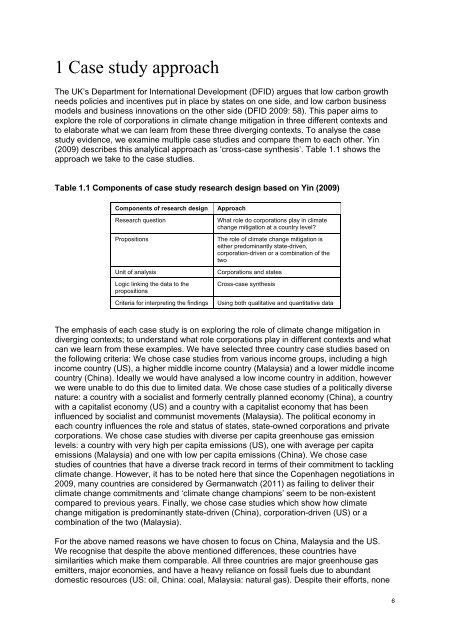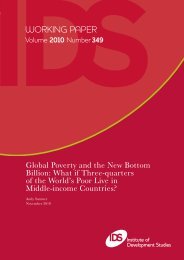IDS WORKING PAPER - Institute of Development Studies
IDS WORKING PAPER - Institute of Development Studies
IDS WORKING PAPER - Institute of Development Studies
Create successful ePaper yourself
Turn your PDF publications into a flip-book with our unique Google optimized e-Paper software.
1 Case study approach<br />
The UK’s Department for International <strong>Development</strong> (DFID) argues that low carbon growth<br />
needs policies and incentives put in place by states on one side, and low carbon business<br />
models and business innovations on the other side (DFID 2009: 58). This paper aims to<br />
explore the role <strong>of</strong> corporations in climate change mitigation in three different contexts and<br />
to elaborate what we can learn from these three diverging contexts. To analyse the case<br />
study evidence, we examine multiple case studies and compare them to each other. Yin<br />
(2009) describes this analytical approach as ‘cross-case synthesis’. Table 1.1 shows the<br />
approach we take to the case studies.<br />
Table 1.1 Components <strong>of</strong> case study research design based on Yin (2009)<br />
Components <strong>of</strong> research design Approach<br />
Research question What role do corporations play in climate<br />
change mitigation at a country level?<br />
Propositions The role <strong>of</strong> climate change mitigation is<br />
either predominantly state-driven,<br />
corporation-driven or a combination <strong>of</strong> the<br />
two<br />
Unit <strong>of</strong> analysis Corporations and states<br />
Logic linking the data to the<br />
propositions<br />
Cross-case synthesis<br />
Criteria for interpreting the findings Using both qualitative and quantitative data<br />
The emphasis <strong>of</strong> each case study is on exploring the role <strong>of</strong> climate change mitigation in<br />
diverging contexts; to understand what role corporations play in different contexts and what<br />
can we learn from these examples. We have selected three country case studies based on<br />
the following criteria: We chose case studies from various income groups, including a high<br />
income country (US), a higher middle income country (Malaysia) and a lower middle income<br />
country (China). Ideally we would have analysed a low income country in addition, however<br />
we were unable to do this due to limited data. We chose case studies <strong>of</strong> a politically diverse<br />
nature: a country with a socialist and formerly centrally planned economy (China), a country<br />
with a capitalist economy (US) and a country with a capitalist economy that has been<br />
influenced by socialist and communist movements (Malaysia). The political economy in<br />
each country influences the role and status <strong>of</strong> states, state-owned corporations and private<br />
corporations. We chose case studies with diverse per capita greenhouse gas emission<br />
levels: a country with very high per capita emissions (US), one with average per capita<br />
emissions (Malaysia) and one with low per capita emissions (China). We chose case<br />
studies <strong>of</strong> countries that have a diverse track record in terms <strong>of</strong> their commitment to tackling<br />
climate change. However, it has to be noted here that since the Copenhagen negotiations in<br />
2009, many countries are considered by Germanwatch (2011) as failing to deliver their<br />
climate change commitments and ‘climate change champions’ seem to be non-existent<br />
compared to previous years. Finally, we chose case studies which show how climate<br />
change mitigation is predominantly state-driven (China), corporation-driven (US) or a<br />
combination <strong>of</strong> the two (Malaysia).<br />
For the above named reasons we have chosen to focus on China, Malaysia and the US.<br />
We recognise that despite the above mentioned differences, these countries have<br />
similarities which make them comparable. All three countries are major greenhouse gas<br />
emitters, major economies, and have a heavy reliance on fossil fuels due to abundant<br />
domestic resources (US: oil, China: coal, Malaysia: natural gas). Despite their efforts, none<br />
6

















